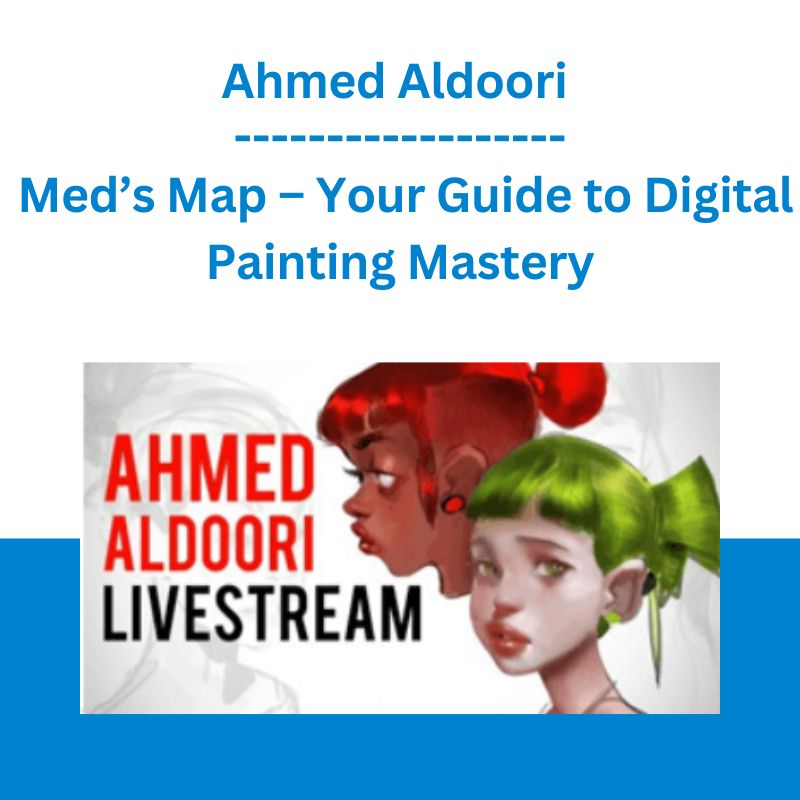*** Proof of Product ***
Exploring the Essential Features of “Ahmed Aldoori – Med’s Map – Your Guide to Digital Painting Mastery”
Learn how to paint like a professional concept artist and digital illustrator in this comprehensive online course.
So you want to be a pro?
My course gives you a clear map to get there.
After 10 years as a concept artist, I’ve compiled all the fundamental techniques you actually need to know into this comprehensive course.
I’ll show you how
I demonstrate the techniques I use in process videos, and I explain how to do them step-by-step.
Lessons start with the fundamentals of digital painting. Then we build into advanced techniques, like painting faces and appealing lighting.
You’ll also level up fast. This course provides the structure of a college-level course and can be completed in 4 months. But, you can work on your own timeline and at your convenience.
Each lesson comes with lecture videos + a guided assignment. This combo will let you practice new techniques until you’re seeing results.
Here’s our lesson plan
1: Rendering Form
You need a strong foundation before you jump to rendering the human face. So, we’ll start by covering the basics. You’ll learn my step-by-step process for rendering cubes, spheres, cylinders, and more. You’ll also learn about value structures and how lighting affects these simple shapes.
2: MedCubes
You’ll learn color theory (both RGB and CMYK) through my simple method. The basics of the color wheel and complementary colors will soon become second nature.
3: Painting Basic Subjects
What brushes do you use?! In this lesson, you’ll learn about brushstrokes, layering brushwork, lighting, and brush economy. Learning is an iterative process, and you’re going to get your practice in here. After this lesson, you’re going to notice development in your confidence and personal artistic style.
4: Building the Skull
We will simplify the human skull into easy-to-render shapes. Knowing the underlying forms, will allow you to easily illustrate heads from different angles.
We will break down the shapes of the skull into spheres, cylinders, wedges, and a magnet shape. We will also be going over some details of proportions of where to place the overall parts in relation to each other, like the cranium as it relates to the mandible.
5: Skulls with No Reference
We’re continuing our subject of skulls, but this time you’ll learn how to draw from your imagination. You’ll learn how to build and draw skulls from different angles. And we’ll continue our discussion about effective lighting on the head.
6: Facial Features, Secret Shapes and Ratios
It’s time to render faces. You’ll learn how I render facial features through their basic forms. And you’ll learn my wireframe method for rendering light on facial features. After this lesson, you’ll have a mental library of what to look for when you are painting a face. There will also be a section on secret shapes and ratios.
7: Color Appeal
We’re going to start building your personal library of color palettes by analyzing color references. You’ll begin to develop an intuition for colors in skin tones. We’ll also cover warm vs. cool colors and high saturation vs. low saturation.
8: Value Technique
Alright, back to faces. You’ll learn how to indicate form, lighting, and contrast on faces using value alone. I’ll show you my techniques for pushing and pulling values.
9: Alla Prima (Direct Painting)
Now we’re taking off the training wheels. This direct painting method will enable you to put together everything you’ve learned so far. I’ll show you my step-by-step method for this technique, which adds color to your toolkit.
10: Stylized Painting
This lesson builds off our previous discussions of facial features and color theory. You’ll learn how to stylize from photo reference. We’ll be pushing and pulling the forms that were carefully studied in earlier lessons.
11: Master Studies
How did the masters stylize their portraits? We’ll analyze the creative choices that John Singer Sargent used in his paintings. That will help you make your own creative choices with lighting, brushwork, lost edges, sharp edges, and focal points.
12: Studying Real Faces
We need to get you away from ideal superhero faces. So in this lesson we’ll analyze the everyday faces that we see in normal life (rather than in movies and games). After this, you’ll be able to create characters that have personality, story, and appeal.
13: Shape Design
Now we’re getting advanced. I’ll walk you through the elements of rhythm, harmony, and repetition. You’ll begin to think about these elements in your own work. And you’ll learn more about shape hierarchy, composition, gesture, negative space, and flow.
14: Appealing Light
You’ll learn how to render appealing light through specific reference images. Together, we’ll break down the elements of lighting so you can begin your own lighting library.
15: Intro to Concept Art
Now that you have all the fundamentals and an extensive toolkit of techniques, it’s time to cover what concept art actually is. You’ll learn how to approach a project and how to make your own portfolio. We’ll be discussing world building, themes, and multiple approaches for sketching and painting heads using reference and your imagination.
16: Applying Lighting and Color
Free Expansion Content: This expands on the Appealing Light lesson. We further dive into actually using lighting in a practical setting and show how it applies to an actual character. We go over the process with three different lighting scenarios using the same sketch.
17: Fantasy Character Painting
Free Expansion Content: Based on the Elden Ring themed artwork from my Instagram feed. The real-time step-by-step process was requested, and here it is!
18: Bonus Style Study
Free Expansion Content: After many requests, this was added as a step-by-step walkthrough of how to take paintings from your favorite artist, analyze them in very easy steps, and then use that information to apply to your own paintings or designs. This lesson is essentially “how to develop your style based on your preferences”!
6 Additional Lessons (Complete Edition Only)
Complete your toolkit with these 6 classic Gumroad tutorials (35 hours of content):
- Character Portraits
- Staging Your Characters
- Composition 1: Understanding Tension
- Focal Points, Rhythm, & Composition
- Masks and Gold
- Tiefling Portrait
5 Hours of Bonus Footage (Complete Edition)
Hi, I’m Ahmed Aldoori
I’ll be your guide on this quest. You might know me from the following:
- YouTube tutorial videos 🎥
- Instructor at ArtCenter College of Design 🏫
- Concept artist for movies, theme parks and video games, including Guild Wars 2 🎮
- World Champion at Limits / Digital Art Battle 🏆
Please see the full list of alternative group-buy courses available here: https://lunacourse.com/shop/









